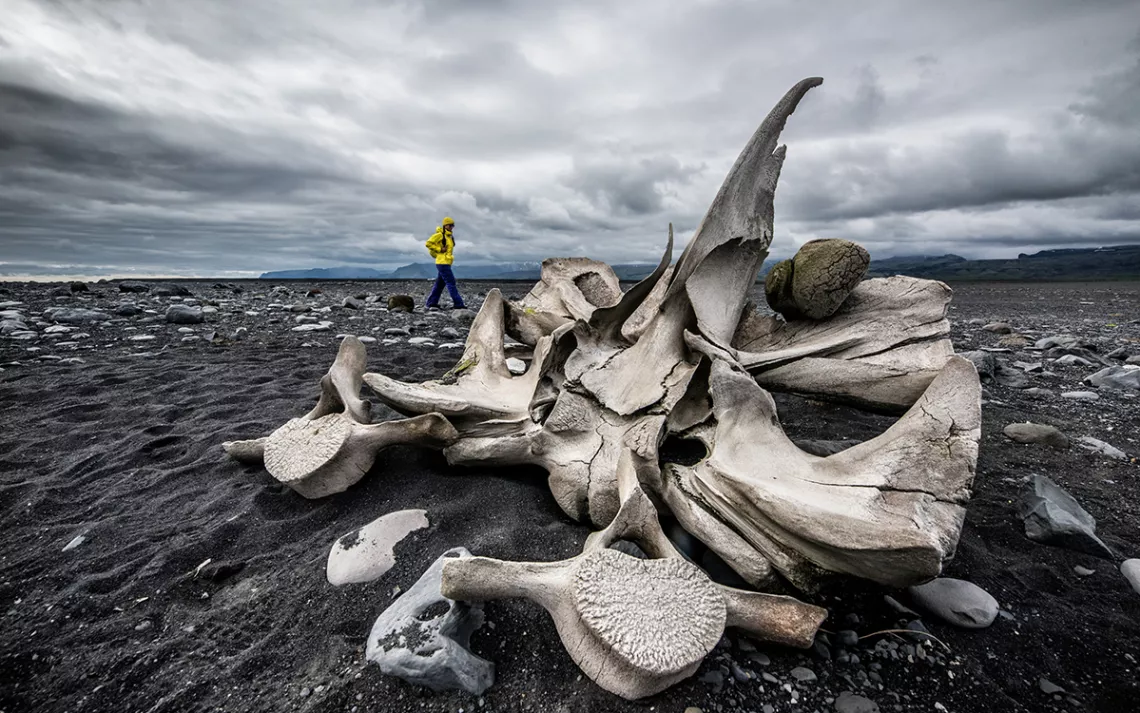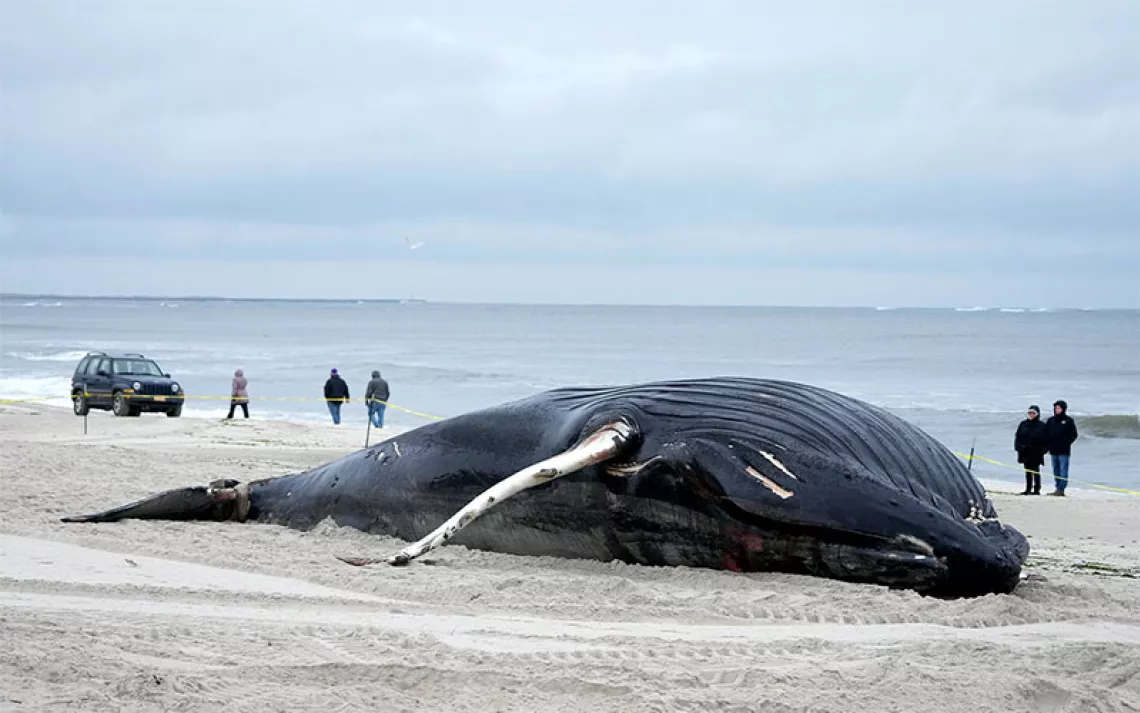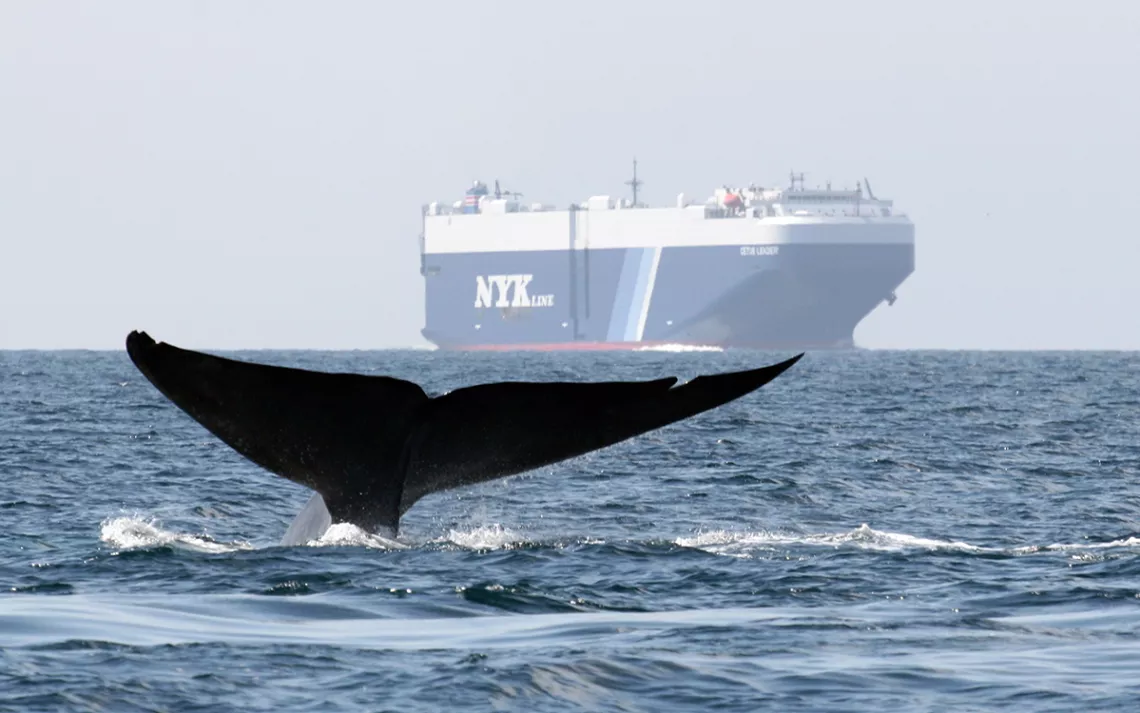How to Unbury a Whale
In remote Maine, a long-dead finback whale made its return

During a walk along Mowry Beach, a rocky and rose-bordered spot on the outskirts of Lubec, Maine, Chuck Kniffen and Rhonda Welcome watched their Saint Bernard puppy, Lola, worry a darkened patch of shoreline. It had become a regular occurrence in the fall of 2014. "She would stop and chew on this disgusting black spot that looked like seaweed or mud or dirt. And I would ask, 'Why does she chew on that every time?'" Welcome recalls. "And Chuck said, 'It's a whale bone.'"
Up at the northeastern tip of the United States, Lubec is a regional hub for lobster fishing as well as a reluctant tourist town of about 2,000 residents. Along Water Street, artwork mingles with remnants of the sardine and herring canning industry that brought the community a measure of commercial success until the end of World War II. Some former factories are now brightly painted studios or museums. Others sit empty, weathering. Lubec is wharfy and wind-burned, worlds away from the polished seaside hamlets, like Camden and Kennebunkport, that draw big crowds of tony vacationers in the summer months. Through squinted eyes, you could be in Maine or Greenland. Naturally, there are whales here.
At the time of their discovery, Welcome was volunteering at sardine-factory-turned-gallery Lubec Landmarks. After she mentioned the whale bone to her fellow volunteers, they filled in the rest of the story: In 1994, a 53-foot, mature male finback whale turned up on Mowry Beach, where the couple took their walks.
When a whale washes ashore, it captures attention. "Everything about whales invokes the imagination," says Dan DenDanto, research associate and director of the fin whale catalog at Allied Whale, the College of the Atlantic's marine mammal laboratory. "The thought of a big, hulking dead thing on the beach seems emergency-level or apocalyptic to some people." The remains of a whale are not an emergency and don't pose a risk to humans for the most part, but moving them takes time and money. It's easier to get an excavator to a whale than to get a whale to a landfill. The people of Lubec buried the whale right where they found it, and returned to their lives. Now, 20 years later, it was making its return.
At the time of the 1994 burial, the people of Lubec didn't realize that burying the whale in anoxic mud would prevent it from decomposing, or that the region's dramatic tides would cause it to emerge, zombie-like, from the muck. "So, 20-plus years later, there was still flesh on the thing. It was still quite gross and nasty, and very oily," says DenDanto, who Kniffen and Welcome had contacted about his side gig of whale bone articulation.
The whale needed to be moved—its situation was ghastly and within a mile of Lubec's center, on one of its most trafficked beaches. And Kniffen and Welcome had hoped that with DenDanto's help, they could reconstruct the whale, turning it into an exhibit.
They'd also alerted Rosemary Seton, the marine mammal stranding coordinator at the College of the Atlantic. "Dead animals are critically important," says Seton. "People often phone us and say, 'There's a dead seal out here; you probably don't want it.' But we do. We do." Conducting necropsies is crucial to understanding the often-enigmatic sea, she explains. "We are the stewards of what's going on in the ocean."
Seton couldn't pinpoint the Lubec whale's cause of death, though she found fishing line near the body. And, given the whale's condition, DenDanto wasn't confident he could reconstruct its skeleton. With their work done, the experts left the whale, once again, to the town of Lubec. Kniffen and Welcome started to organize.
In a series of open meetings, they quickly found that their neighbors were eager to give the whale a proper burial. A local contractor offered his backhoe at no cost. The owners of Eastland Motel suggested their property as a resting place for the whale to decompose properly. Builders and farmers donated sawdust and manure to cover the carcass, so bacteria and fungi could clean its bones.
For two years, as the bones sat, finally decomposing, Kniffen and Welcome wondered what to do with them. The couple obtained a NOAA permit to keep the bones for an educational exhibit. They wanted to honor the whale, sharing it with the community that had worked so hard to care for its body the second time around. Welcome began illustrations for a children's book called Putep, the Passamaquoddy word for whale.
Today, however, parts of the Lubec whale reside at Turtle Dance Co-op, in the old Peacock building on Water Street, which was once a packing facility for the R.J. Peacock Canning Company. Though the building has no power or running water, Kniffen and Welcome use it as a gallery for work by local authors and artists, plus "sea junk art" made from waste Kniffen collects from the ocean during kayaking trips.
The room is dark and drafty, but the atmosphere is festive. On the back wall is a mural of a turtle and a mermaid sitting in the sun. Kniffen's sea junk puppets hang playfully around the room. It's busy, with lots to look at, and if you're not careful, you might miss the 13-foot whale jawbone sitting at the co-op's entrance, so vast it disappears into the architecture. Making a fist, I knock on it and listen to the muffled clunk of my knuckles. The bone is pock-marked and earth-toned, and inviting.
It's been precisely eight years since the exhumation when I visit Kniffen and Welcome in Lubec. "In all of those [years], kids were touching the bones. We took the bones to the Maine Children's Museum. People came in here, they sat beside the bones. They took pictures with them," Welcome says. "It seemed like [the whale] already had a purpose."
"At work," Kniffen interjects. "It was at work," Welcome agrees.
Toward the back wall are more bones: a rounded bowling-ball-size socket, vertebrae like a steering wheel, fin bones. Hand-written identifications are tied on with faded green ribbon. They are weighty, to hold but also to absorb. Resting my hand on the ossified curve of its tibia, I considered its function and how it helped propel this whale, likely many times in its life, between Svalbard and the Antarctic Sound. It was like being in proximity to a spaceship that's traveled to the moon.
A whale, though, means different things to different people; some have soured on the marine mammals since the community came together in 2014. Livelihoods in Lubec have suffered in the wake of recent conservation rules aimed at protecting endangered North Atlantic right whales from their two main causes of death: getting hit by a boat or entangled in fishing gear. Last month, a federal court rejected the Maine Lobstermen's Association's bid to overturn the rules, which, they had argued, are too restrictive.
In such a context, the attention a dead whale can bring is not particularly welcome. Prior to my reporting trip to Lubec from my home in southern Maine, I received both private and public messages telling me to stay away.
As we spoke, Kniffen and Welcome defended the needs of the lobster industry, and the people depending on it. But humans, too, have already asked a great deal of whales. They're the charismatic subjects of novels, movies, paintings. We've hunted them for meat, and oil, and bones, many groups to the brink of extinction.
We're not the only ones drawn to them. In recent years, the afterlife of a whale has become an area of study in the scientific community, with studies finding that whale carcasses create "biological carpets" on the ocean floor that spawn and sustain new life. When a whale carcass descends to the deep ocean floor, it's called "whale fall." Fallen whales can be "important little islands for the propagation of a whole variety of vertebrate and invertebrate communities, that sort of blink on and out, as they forage and recycle the composting whale on the bottom of the ocean," DenDanto says.
"Our understanding of the importance of whale carcasses to ecology has moved tremendously in the last 20 years," DenDanto elaborates. "And what we found out about whales is that they're probably a lot more responsible for life than anybody had ever given them credit for, just in terms of whole communities arise around a whale fall." Dead whales, we are learning, could be just as important as live ones.
Welcome doesn't want the bones to live indoors forever—she wishes to see them nurturing life. She imagines a large tank out on the wharf, where visitors can see the bones submerged in water, emulating whale fall. Discussing the future of the bones, Kniffen made a distinction between learning and feeling. "We put it in a museum and call it science. And to me, there's a disconnect there. That's all intellectual, you know what I mean: 'What can we learn? What can we study? What can we know?'" he says, paraphrasing an academic mindset. "Instead [we should be asking], 'What can we feel?'"
On a windy afternoon at Turtle Dance, with Hurricane Fiona bearing down on Lubec, Welcome mused on her theory about the pull whales have on us. "I think they release things in our imagination—about the possibility of the entire planet."
There is no escaping feelings in the presence of whale bones, which have their own still atmosphere. And, as Welcome indicated, a subtle potential. Over months and years, bones and flesh become new ecosystems. Above or below the ocean's surface, they are capable, for a time, of creating communities.
 The Magazine of The Sierra Club
The Magazine of The Sierra Club



